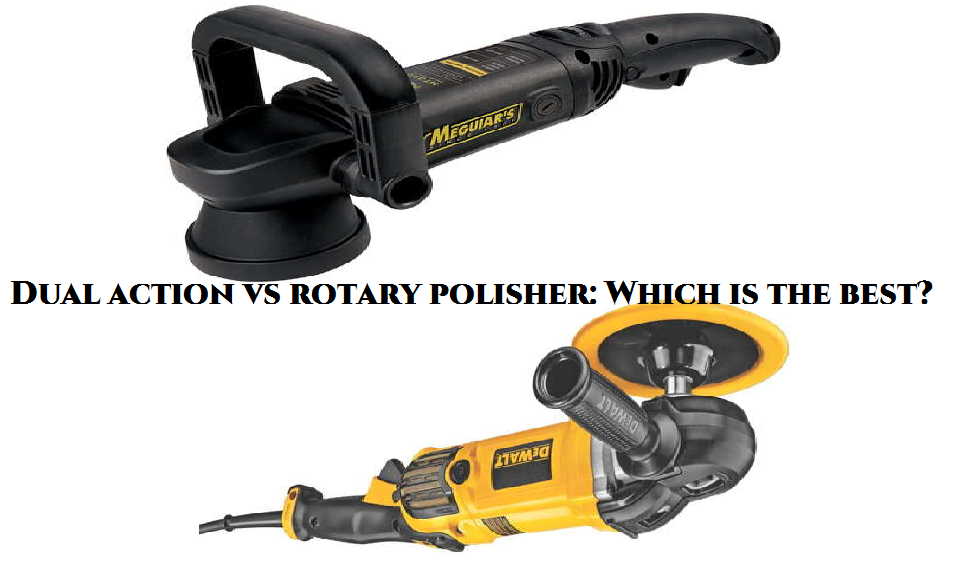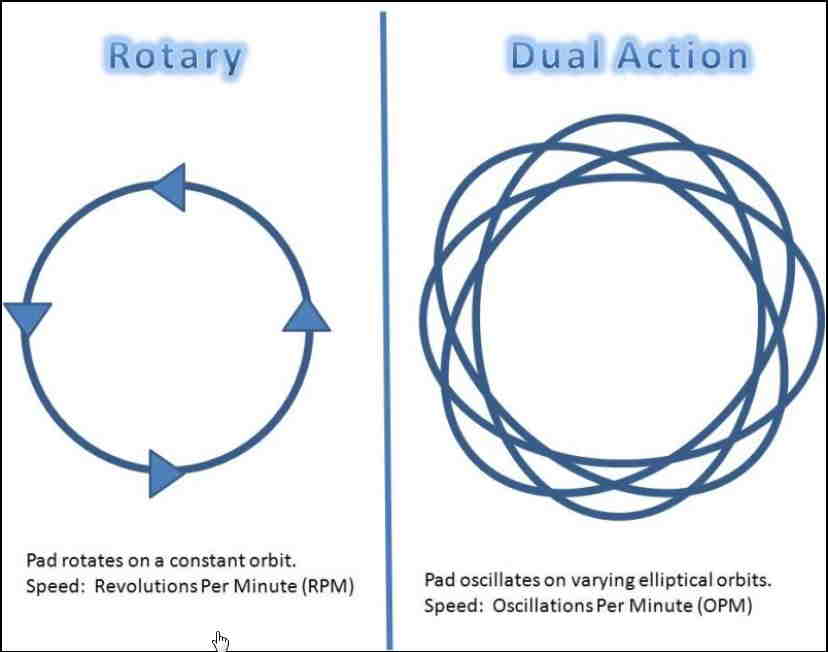As an Amazon affiliate, we earn a commision from qualifying purchases.
For a professional detailing job, you certainly need the right tool for the job- and for a lot of detailers and car enthusiasts, the choice boils down to dual action vs rotary polisher.
Now, both devices will do a great polish job but are there are differences that you need to keep in mind when choosing between the two.
With that in mind, here is a lowdown on how each tool works and when you should go for either polishing machine.
Dual action vs rotary polisher: what is the difference between a dual action polisher and a rotary polisher?
Before you take the leap towards either polisher, here is what you should know:
Overview of the Dual action (DA) polisher
A DA polisher is so-called because it creates a double action (we are coming to this in a second) when polishing, buffing, applying wax, adding paint to surfaces, or sanding.
I promised to come back to the term “double action” so here we are: the dual-action simply means the polisher oscillates and rotates (spins) at the same time when operating.
In short, the entire operation mimics earth’s motion – back in school, you may have learned that the earth spins (on its axis) and concurrently revolves (orbits) around the sun.
What is more important to note is that the dual motion made by the head – circular and spinning- is so vital when polishing surfaces…
Here is why:
- The polisher is super safe– The motion (which is essentially a sort of “jiggling” motion) reduces the risk of burning the paint greatly when polishing your car. The motion makes it impossible to apply excessively concentrated pressure in a single place (at one time), protecting the paintwork.
- Produces higher quality finish– Overall, a DA polisher is more effective than its counterpart again because it also oscillates instead of just rotating so you can easily avoid the nightmarish buffer swirls (or holograms) in your finish provided you’re using the right chemicals, pads, and bonnets.
Away from the unique motion, it is pivotal to note that these types of polishers are extremely user-friendly.
The reason is that on top of producing less heat versus a rotary polisher, they tend to be smaller, way lighter, and much easier to maneuver.
In a nutshell, if you’re a beginner, don’t look any further than a DA polisher.
Overview of the rotary polisher
Rotary polishers are classics- they not only have been around for a very long time but they still continue to be a preferred choice among legions of pros and staunch hobbyists.
Why?
They do a large amount of paintwork pretty quickly.
Put another way, the greatest advantage of a rotary over DAs is speed– They’re quicker even when removing the hardest paints making them the perfect choice where time is a key factor/where you encounter some really hammered situations in your day-to-day projects.
Question: how exactly does a rotary polisher work?
In truth, they’re drastically different with regard to the way they operate compared to a dual-action polisher.
Take a look at the following image just before we proceed…
Dual action polisher vs rotary – operational action illustrated
Image credit: meguiars.co.uk
You see, the drive unit in rotary polishers is called a direct drive.
If you’re confused by what this implies, it simply means that the auger (the threaded part onto which the backing plate is attached), is driven directly, of course, off the motor.
The result is an immensely powerful rotating motion (don’t forget that there is only a single spinning motion on the axis here) that can tackle plenty of work faster than a DA polisher.
Keep in mind that you’re in charge of ensuring the polisher moves while it spins so you can better concentrate on areas that need more alertness such as deeper paint scratches.
Naturally, there is danger in employing more downward force – increased friction and heat- but all should be fine if you have sufficient skills to control it as it bites deeper and deeper.
Rotary polisher vs DA polisher: cons associated with each type
Though we have concentrated on the strengths of each unit so far, there are cons you need to be aware of:
Dual action (DA) polisher cons
There is one major con here in that……..
It doesn’t cut deep enough
The unit will make the scratches look better and even get rid of nearly all swirls.
However, as mentioned before, the heat it produces is generally not enough to enable it to cut deeper into the paint.
That being so, of the two, the best polisher to use for deeper scratch removal (and other tough jobs) is a rotary polisher as long as you are sufficiently experienced.
DA polisher vs rotary polisher: Rotary polisher cons
As already hinted, the rotary polisher is not faultless either.
Below are its two primary downsides:
It needs good skills
In general, the tool is only productive when used properly- most of the nightmare experiences you might have heard are likely to have been cases of a rotary polisher in the hands of a beginner.
Why is this so?
Simple! The tool swiftly burns the paint if it lingers on one spot for too long.
To be frank, you will cause a lot of mess if you don’t keep it in motion at all times (remember the pad usually spins at insane speeds).
To cut the long story short, a rotary polisher needs more attention hence we recommend them for professionals only (unless you’re willing to binge-watch YouTube tutorials to improve your skillset).
Follow up work may be necessary
For the most taxing jobs, the tool will do the heavy lifting without necessarily applying the perfect finish.
For this reason, you may need to do some follow up work with a DA to ensure you get a flawless finish.
Dual action vs rotary polisher – our top picks in each category
Now that we have filled you on the basics, here are our recommended picks in each category:
Best dual action polishers
- Meguiar’s Dual Action DA Car Machine Polisher – solid and very well built.
- Ginour 900W 6inch Variable Speed Polisher,Dual-Action– unmatched durability and speed.
- C P CHANTPOWER 6-Inch Dual Action Polisher Buffer– best dual action polisher for beginner.
Best rotary polishers
- DEWALT buffer-polisher combo, Soft Start, Variable Speed, 7-Inch/9-Inch – most comfortable professional grade polisher.
- WEN 6010 6-Inch Waxer/Polisher –best budget waxer/polisher unit
- Makita 9237C 10Amp 7-Inch Polisher/Sander – best premium grade rotary polisher for detailing/polishing
Wrapping it up
There goes the difference between rotary and dual action polishers and the situations that suit each polisher best.
We believe that this will point you in the right direction
Till next time.
ALSO READ:
Orbital sander vs mouse sander (orbital sander vs detail sander)
Electric sander for car bodywork- top 3 picks in the market


